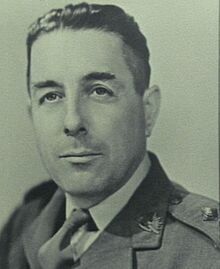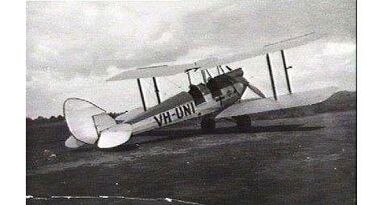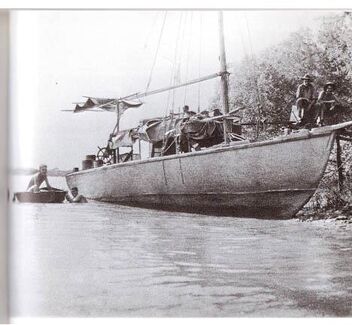
Alfred Boxall
Birth: 16 Apr 1906 - Middlesex (England)
Death: 17 Aug 1995 - Canberra, Australia
Marriage: 16 Nov 1937 - Waverley, New South Wales, Australia
Parents: Frederick Boxall, Louisa Tilbury
Spouse: Dulcie Isobel Smith

Building an airstrip At the time, there was an airstrip adjacent to the Roper River but it was unserviceable during the wet season. So, with the help of Jack Mahoney the local policeman at Roper Bar, an alternative site chosen. A nearby mountain had a comparatively flat summit and the Nackeroos, armed only with a blitz truck, a tow chain and the help of the local Aborigines headed off to make an airstrip. The Territory’s Flying Doctor, Clyde Fenton, had issued instructions via the wireless concerning the minimum dimensions and the Nackeroos, with the Aborigines, laboured for ten sweltering days to clear 900 meters of scrub.
Clyde Fenton flew a twin-engine Dragon-Rapide and was accustomed to rough airstrips but he found the Nackeroos’ efforts particularly uncomfortable. However the airstrip served its’ purpose and Henry was flown to hospital. Alec Boxall remembered how terrified Henry was of the aircraft:
“Fenton had to okay an additional passenger, an old white-bearded Aboriginal man, otherwise Henry wouldn’t have got on board. He was scared of the plane and I don’t think the old man was too happy either because he had a fatalistic look on his face as he sat beside Henry. As though he had a job to do and that was that! I did hear that young Henry got on all right. He didn’t lose his leg, which was surprising when you consider those conditions; the climate, the possible infections and the ten days it took us to build that airstrip.”

A quart of butter in the sump’ The old work horse was the Hurricane. It had been a fishing boat and we had two old timers running it. They were absolutely magnificent. They’d go anywhere, do anything and were as reliable as the sun. Like most small ships at the time, this old fishing vessel had be seconded by the army for military use. The Hurricane wasn’t in good condition, nor was it particularly seaworthy but the Nackeroos managed to keep it afloat and put it to great use, supplying men and provisions to out posts that were isolated during the wet season. It was one of the NAOU’s eight small ships.
To the NAOU, the value of small ships like the Hurricane was immeasurable. Eight vessels were manned and maintained by the Nackeroos as part of Stanner’s plan to explore and investigate the northern rivers and inlets. Many of the NAOU outposts were accessible only by water and great risks were taken, particularly in the wet season, to get men and supplies to these posts. Considering the thousands of kilometers of deserted coastline for which the NAOU was responsible, eight small vessels seems grossly inadequate. Yet in 1943, NT Force reported only having only fourteen vessels (These included NAOU’s eight). There was a general shortage of vessels in Australia because the Army had seconded 299 small craft for the New Guinea to Torres Strait region.
The NAOU’s ketches and launches were all under fifteen metres in length and capable of of working in depths of less than two meters; an advantage in the muddy upper reaches of the rivers. No hydrographic charts were supplied, although one Nackeroo searching for a coastal outpost with the aid of an 1803 Matthew Flinders’ Chart.
The ranks of the NAOU included mariners, shipwrights and mechanics . With few resources, amazing ingenuity and a fair portion of good luck, these men salvaged and repaired a number of small ships and kept them operating. Sergeant [Alf] Boxall, a qualified motor mechanic, found an emergency substitute for engine oil: “We were on the Hurricane, out in the Gulf heading towards the mouth of the Roper River when we started to run low on oil. We had spare oil cans on board but when we went to use them we discovered they were full of water. At this point we still had 100 mile [160 kilometers] to go to our base at Roper Bar. I knew we couldn’t make it without extra oil. Then I remembered that a case of butter had been left on the boat, some weeks before. I said to the crew, ‘from now on, no matter how long it takes, this engine must not stop. It mustn’t get cold.’ Then I picked up the first can of butter (in that heat it was just like water), opened it and poured it into the engine. By the time we reached Roper Bar I’d used the entire case of butter. As we moored the Hurricane, I stopped the engine, removed the sump plug and drained the butter out. There was only a quart [just over a litre] of butter left in the sump. We quickly poured new oil into the engine and started it. It was fine but smelled of burnt butter for the next week.”
[Alf] Boxall spent many months on the NAOU vessel Hurricane with Mordecai as his guide. "Although he’d been initiated into the tribe, Mordecai had come under the influence of the local mission. He could read write, and do elementary mathematics. he was a fine man; strong intelligent and very much the leader.”